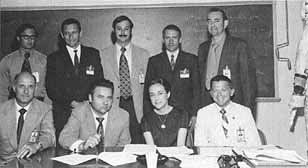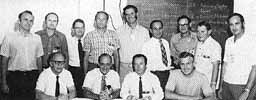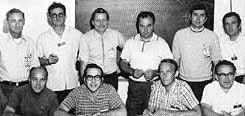
July in Houston
Between 6 and 18 July, the days were busy ones for the ASTP Working Groups. Each group had a full agenda that it wished to see completed, but the work went slowly at some points tediously - because of the language barrier. M. Pete Frank, chairman of Working Group 1, for example, recorded in his notes:
Don't seem to be able to complete anything quickly.
Spent a lot of time on correcting or modifying unimportant trivia.
Translations cannot be trusted. . . .
Russian language takes about twice as long to say as does English.
Much time was spent trying to understand jargon. . . .11
R. H. Dietz, commenting on the communications equipment talks, stated, "It was found that diagrams, pictures, etc., were very useful in our discussions. In fact, the written word would cause many hang-ups, but when a picture or diagram was used, immediate understanding usually resulted. This applies to both sides."12 As the two teams became more deeply involved in the nitty gritty details of laying out a flight, specificity of meaning and complete understanding of the other side's approach were essential. And they were difficult.
Some Americans found this laborious point-by-point negotiating frustrating, having brought to the meetings expectations about how much work needed to be accomplished and at what pace. But the Soviets introduced a different perspective to the same sessions. Glynn Lunney later reflected on this problem:
we had the experience at a couple meetings in the beginning where we would be planning to cover certain ground, and from our point of view it seemed [199] that they were not quite as prepared or ready . . . as we were. Again in retrospect, we have consistently had the same class of problems when we deal with new contractors, in the sense that when we get on board with a contractor we all have a certain way of doing business. . . . And after a while we come to take it for granted and expect everyone else to know what it is. . . . To some extent we had that kind of problem in ASTP in the beginning.13
While the Soviets would have to master the NASA method of working a problem, the Americans also had to prepare themselves for the surprises that their counterparts could spring. Several individuals at MSC were still trying to adapt to the switch from Salyut to Soyuz when they learned almost by accident that the Soviets planned to have two spacecraft ready for launch to ensure mission success.
There had been considerable discussion during the first day's negotiations in Working Group 1 about who should launch first - Apollo or Soyuz. Clarke Covington recalled the events leading up to the discovery of the two Soyuz spacecraft and launch vehicles. "We had drawn up a proposed mission plan that showed Apollo going first . . . primarily because Apollo had extended mission time when compared to Soyuz; 11, 12, 13, 14 days. They had this man-day limitation which limited them to about 4 days plus a day margin." Having taken this difference in capability into account, the MSC mission planners figured that Apollo should launch first; then it could wait for the Soviets if their first launch attempt were unsuccessful. According to Covington:
They came in with a plan where Soyuz was launched first. We discussed this for several hours, not really knowing or understanding their reasons. They went through a lot of flight mechanics type [explanations]. All of our Working Group 1 people were . . . trying to understand why they wanted to go first. It was really . . . illogical. We were convinced, this was privately, that they had a fear of failure.14
At the end of the day, Covington received a copy of the Soviet "Project Technical Proposal" in Russian. Believing that he ought to know what was in that document before starting the next day's discussions, he went looking for a translator. Covington talked Ross Lavroff, one of the interpreters working with MSC, into orally translating it. They went to Covington's office at about eight in the evening, and Lavroff began the all-night task. After several hours, Covington heard Lavroff read something to the effect that the Soviets proposed to launch Soyuz, which would be followed by the launch of Apollo. Should all possible alternative launch attempts prove unsuccessful, the first Soyuz would deorbit, and the second one would be prepared for launch. Since there had been no mention of a second Soyuz [200] during that first day of talks, Covington asked Lavroff to read that part again. Surely, he had mistranslated; there must be another way of interpreting that passage. Lavroff read it again. If the first Soyuz has to come down, then the second will be launched. Covington was astonished.
Early the next morning, Covington cornered Lunney before he began his "tag-up" staff meeting, which preceded each day's negotiations, to tell him that the Soviets had not one but two Soyuz craft and launch vehicles allocated for ASTP. Lunney, also amazed, said that he would indeed ask the Soviets about this interesting piece of news. At the morning session, the Soviets responded. Yes, they would have a second Soyuz ready for launch. American Working Group 1 members just "sat around dumbfounded. . . ." Covington said, "that totally cratered our argument as to the need for Apollo to go first. If they are willing to launch two spacecraft then there wasn't any reason why they should not go first." But why had they not revealed the details in the beginning? No one at MSC ever knew why; they just accepted it as one of the Soviet idiosyncrasies around which they would have to work.15
Despite the surprises and the frustrations, a considerable number of points were settled at the July meeting. Lunney and Bushuyev signed the three basic documents that they had agreed to prepare in April the "Project Technical Proposal," describing the mission plan and the hardware; the "Organization Plan," stating how the project would be controlled and managed both prior to and during the flight; and the "Project Schedules," a time table for Working Group activities. In addition, the two Technical Directors decided to expand the number of Working Groups from three to five. Working Group 4, chaired by R. H. Dietz and B. V. Nikitin, would concentrate on the communications and tracking questions that originally had been part of Group 2's purview, while Working Group 5, under the direction of R. E. Smylie and I. V. Lavrov, would handle the environmental control and crew systems topics originally assigned to Group 1.16
Lunney and Bushuyev, together with Kraft and Petrov, met with the press on 17 July to talk about results. Lunney described the mission profile as it had evolved to date:
We've agreed that we would launch the Soyuz spacecraft first from the Soviet Union. There would then be three launch opportunities for the Apollo spacecraft, the first one occurring about 7½ hours after the launch of the Soyuz. We envision a rendezvous sequence by Apollo spacecraft, the command service module, which would take approximately 1 day. At the end of that 1 day, we would arrive at stationkeeping conditions, and perform the final docking, and we would perform that actively with the Apollo spacecraft as the active docking spacecraft. After this docking we have planned for a period of approximately 2 days, about 48 hours, during which time an agreed schedule of exchange of crews between the two ships would occur. We have [201] also allowed time for the performance of . . . joint experiments in any scientific activities that we will be able to fly on either or both of our spacecraft. After this period of approximately 48 hours, the vehicles would undock and then would carry out any objectives that either country would have on its own for this particular mission. We have not finalized for the Apollo how long we would stay up because it depends on precisely what experiments we would carry, but as that period drew to a close, we would plan on a relatively normal de-orbit sequence with the landing in the Pacific Ocean.17
This mission plan represented the detailed agreements that had been reached by the Working Groups.
Group 1 members involved with the mission profile had agreed that the launch would take place in July 1975. While 1 July was "tentatively selected as an arbitrary launch date for purposes of compatible trajectory plans," dates between July and October would be considered. The Soviets agreed to provide the Soyuz orbit parameters to NASA within six hours after their launch so the Americans could update the Apollo trajectory. Information that might affect the rendezvous would have to be provided with maximum accuracy and immediacy. A major issue involved the question of attitude control during the mission's docked phase, but this problem remained unresolved for a time. Both Apollo and Soyuz had limited amounts of fuel for their attitude control systems.
As to crew and flight controller training, the specialists decided that mandatory joint crew training would include familiarization with both spacecraft and preparation of a "Crew Activities Plan" and a "Detailed Operational Procedures" document. At the next meeting, they proposed to exchange plans and schedules and also decided to develop training procedures for the flight controllers that would embody joint simulations between the Soviet and American control centers.18
Members of Working Group 1, who would soon splinter off to become Group 5, wrestled with questions concerning life support systems and crew transfer. Noticeably absent from the Soviet delegation that summer was Ilya Vladimirovich Lavrov, who had been Ed Smylie's counterpart and the sole Soviet negotiator in the earlier discussions on environmental control systems (ECS). Yuri Serafimovich Dolgopolov acted in Lavrov's place. And to the Americans' dismay, Dolgopolov, who specialized in water, food, and waste management aspects of the life support system, did not have a fundamental knowledge of the Soyuz systems that provided oxygen and eliminated carbon dioxide and other waste products from the spacecraft atmosphere.19
During the ECS discussions, Yuri Stepanovich Denisov assisted Dolgopolov, but the Americans were still perplexed. A few days before the meeting began, they had received the first schematic diagram of the Soyuz ECS. It indicated the presence of oxygen and nitrogen in pressure bottles in place...
[202]
|
|
Picture time in Houston for members of Working Group 1, July 1972: seated (left to right), T. P. Stafford, L. A. Gorshkov, N. K. Latter, and M. P. Frank. Standing (left to right), J. H. Temple, O. G. Sytin, E. G. Lineberry, Yu. S. Denisov, and R. J. Ward. Working Group 5 was photographed just before the Saturday lunch break: seated (left to right), T. Holmes, R. E. Smylie, and Yu. S. Dolgopolov. Standing (left to right), J. D. Hollan, J. R. Jam, W. W. Guy, and W. R. Hawkins. |
|
|
|
...of the chemical bed oxygen regeneration system used in previous Soyuz spacecraft.20 When Ed Smylie and Walt Guy asked for an explanation, the two Soviets were at a loss to explain whether it represented the system currently in use or whether it was a proposal for the future. Without a definitive answer, the Americans asked for more details to be provided at the next meeting. From these discussions, Smylie and his Manned Spacecraft Center (MSC) colleagues were beginning to get an understanding of the nature of the problem experienced during the Soyuz 11 reentry. That fatal leak, still shrouded in mystery, could not have been corrected on board. Once pressure was lost, there appeared to be no way to recover because the cosmonauts carried no bottled oxygen. As a consequence, the Americans asked the Soviets to consider the inclusion of an emergency repressurization system for the ASTP flight, if such a system was not already embodied in the Soyuz ECS design.
Walt Guy recalled that in July 1972 the Americans still believed that the Soviets had bottled nitrogen aboard Soyuz for leakage makeup. Only much later did they learn that there were no gas stores on board at all. When this became clear, the Americans understood why the Soviets insisted upon a virtually leakproof spacecraft. According to Guy, "They had implored us [203] from the beginning to tighten our leakage [rates]," which were "10 times greater than theirs." Where the Soviets tolerated virtually zero leakage, it was not unusual for the American spacecraft to lose up to a "tenth of a pound per hour, [and] that is not really very many pounds in a normal mission." In Apollo, the Americans compensated for this loss by carrying extra oxygen.21
Even though Dolgopolov had not prepared any documentation prior to the joint July sessions, he, Guy, and Jim Jaax drafted four Interacting Equipment Documents that described spacecraft environment. In addition, the Americans gave the Soviets data on space suits and prebreathing units that they expected to use. In large measure, the U.S. desire to understand the Soyuz environmental control system arose from the need to make some immediate decisions about the design of the docking module.
Concurrently with the Soviet-American meetings, the first Preliminary Design Review (PDR) with the engineers from North American Rockwell was held at MSC on the 13th. At the PDR, Guy and Jaax had to make some changes in the docking module ECS schematics to reflect the changes negotiated the night before with Dolgopolov. These modifications were a result of the Soviets' concern about the safety of some of the valves that led to overboard gas vents. Where the Americans relied upon the basic design of the valves to ensure safety and carried extra gas in case of valve failure, the Soviets wanted a redundant valve in the overboard system as an extra precaution.22
While the life support people were exploring these topics, the combined Group 2 and 4 team were negotiating an agenda full of items that were an extension of their work done during May in Moscow. In addition to completing interacting equipment documentation covering external lights, docking targets, control system use, and associated rendezvous and docking questions, they solved the thorny problem of "exchanging versus building" communications and tracking equipment. NASA agreed to provide the Soviets with the Apollo lunar module VHF transceivers and range tone transfer assemblies. R. H. Dietz told his counterparts that the Americans would manufacture the Soviet frequency VHF/FM radio communications equipment for the command module. Other topics included cable communications and electrical connectors between the two spacecraft and the type of television cameras that would be transferred from one craft to another.23
Group 3 concentrated on spelling out more fully specifications for the docking system. Some refinements were made in the guides and other parts of the mechanism; as with the other groups, a schedule for the upcoming months was written, indicating documents to be prepared and tests to be conducted. After the team had a thorough look at the American two-fifths-scale docking system, which helped the designers discuss the operation of the...
[204]
|
| |
|
Working Group 2, July 1972: seated (left to right), I. K. Kupriyanov, D. C. Cheatham, V. P. Legostayev, and H. E. Smith; standing (left to right), Dmitri Zareschnak, R. L. Berry, C. E. Manry, O. I. Babkov, R. Reid, V. A. Podelyakin, K. J. Cox, I. P. Shmyglevskiy, and S. E. Snipes. In another part of Working Group 2 activities, V. P. Legostayev (left) receives an explanation from D. C. Cheatham on the operation of the proposed centerline television docking guidance system. Standing behind Cheatham is Ralph Sawyer, Chief of the Telemetry and Communications Division at the Manned Spacecraft Center. |
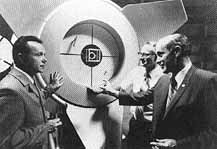 |
|
| |
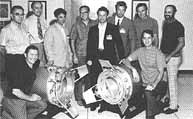 |
At left, Working Group 3 members pose with the American two-fifths-scale model of the ASTP docking system. Left to right: A. Sementovsky, E. N. Harrin, V. I. Bagno, D. C Wade, V. S. Syromyatnikov, Ye. G. Bobrov, W. K. Creasy, and L. G. Williams. Kneeling by the docking hardware: K. A. Bloom (left) and R. D. White. In the lower photo, C. C. Johnson (foreground) is explaining an idea about the compatible docking mechanism to Soviet and American members of Working Group 3. Around the table from the left are L. G. Williams, D. C. Wade, W. K. Creasy, K. A. Bloom, E. N. Harrin (partially obscured), V. I. Bagno, B. S. Chizhikov, Ye. G. Bobrov, V. S. Syromyatnikov, and R. D. White. |
|
| |
|
| |
|
Working Group 4 (below): seated (left to fight), M. W. Hamilton, E. E. Lattier, O. I. Babkov, and O. G. Ispolatov. Standing (left to right), P. W. Shores, V. A. Raspletin, R. H. Dietz, A. S. Morgulev, A. D. Travis, and Dmitri Arensburger. At right, Ye. G. Bobrov, Soviet docking specialist, questions Bob White (left) and Ezi Harrin about the operation of the Apollo docking probe. L. G. Williams and W. K. Creasy stand in the background. |
|
|
| |
[205] ...mechanism and decide on refinements, they scheduled joint model tests for December. Then the engineers would be able to see just how the interfacing elements of one country's system mated with those of the other. The Soviets said they would draft the "Test Plan for Scale Models of Apollo/Soyuz Docking System" (IED 50003), while the Americans drew up the dimensions of the model and the test fixtures.
The last day of joint activities in Houston, 18 July, was given over to final preparations of the documents.* With the departure of the Soviets, the MSC personnel directed their full attention to preparing for the next sessions, scheduled for October. The afternoon of the 18th and most of the 19th were spent in debriefings.24 Working Group chairmen summarized the events of the preceding two weeks for their colleagues and Director Kraft. Looking at the overall rate of progress, Lunney thought that the Soviets were gearing up more slowly for ASTP than was NASA, but this was due in large part to the difference in building cycles for the two types of spacecraft. NASA was faced with a declining work force at the North American Rockwell factory in California, since CSM 111 and the modification kit for CSM 119 would be the last of Apollo. Lunney reported that we "wanted to get all the work done as soon as we could." The Soviets, on the other hand, were building their Soyuz on a serial production basis with no signs of diminishing their activity. They could take a more leisurely approach to finalizing design elements. NASA's expeditious building of hardware was entirely consistent with the agency's modus operandi, according to Lunney.
In general our approach is a go-go thing. For good reasons - that is not to say that it should be hasty - but generally we've found that it doesn't do you any good to dilly-dally around and leave problems hanging around for a long time. They just multiply, and you end up with more snakes than you can kill in one week, if you don't start stomping them as soon as they show up. So we just plunged into this thing with our typical gung-ho approach.25
During the next 70 days, MSC was kept busy. As engineers and designers spent late hours at their drafting tables, development tests were conducted and more design reviews were held.26 Lunney chaired ASTP staff meetings at 1:00 p.m. every Friday to summarize the week's activities and assign "action" items for the next week.27 (See box below.) As the liaison between MSC and NASA Headquarters, Lunney also kept Apollo Program Director Petrone informed of the progress being made on ASTP. Headquarters in turn kept the White House and the Congress advised.28 This cycle completed, it was time for the next round of talks.
Chronology of Manned Spacecraft Center Activities - July-Oct. 1972
|
Date |
Location |
Meeting/test |
|---|---|---|
|
6-18 July |
Houston |
Joint U.S./U.S.S.R. meetings. |
|
18-19 July |
Houston |
MSC management debriefings. |
|
22-28 July |
Houston |
Thermal vacuum test of ASTP docking gaskets at JSC's Space Environment Effects Laboratory (SEEL). |
|
25-26 July |
Houston |
Working Group 4 and Apollo Spacecraft Office staff discuss work for October joint meeting. |
|
27 July |
Houston |
Preliminary Design Review (PDR) no.2. |
|
28 July |
Houston |
ASTP staff meeting. |
|
2 Aug. |
Houston |
Crew Systems Division meeting with North American Rockwell (NAR) representatives to discuss life support system breadboard test. |
|
2 Aug. |
Houston |
Meeting to discuss service module reaction control system (RCS) design and external thermal constraints. |
|
4 Aug. |
Houston |
ASTP staff meeting. |
|
8 Aug. |
Houston |
Service Module RCS design and thermal criteria meeting. |
|
11 Aug. |
Houston |
ASTP staff meeting. |
|
18 Aug. |
Houston |
ASTP staff meeting. |
|
21-24 Aug. |
Downey (NAR) |
PDR no. 3. |
|
24 Aug. |
Houston |
Telecon with the Soviets. |
|
25 Aug. |
Houston |
ASTP staff meeting. |
|
28 Aug.-30 Sept. |
Houston |
Thermal vacuum tests of ASTP docking gaskets at JSC's SEEL facility. |
|
1 Sept. |
Houston |
ASTP staff meeting. |
|
5 Sept. |
Houston |
October agenda telexed to the U.S.S.R. |
|
6 Sept. |
Downey |
Walk through review of plywood mockup of docking module; representatives were present from NAR and the Astronaut Office. |
|
9-15 Sept. |
Houston |
Space Environment Test Division and Engineering and Development Directorate hold meeting on testing to be conducted on docking module. |
|
13 Sept. |
Houston |
ASTP staff meeting. |
|
13 Sept. |
Houston |
Telecon between G. S. Lunney and G. Jeffs, NAR, to review activities. |
|
13 Sept. |
Houston |
ASTP management review for R. A. Petrone, with representatives present from Headquarters, KSC, and MSFC. |
|
20-21 Sept. |
Downey |
Design Review of docking system layouts and assembly drawings. |
|
22 Sept. |
Houston |
ASTP staff meeting. |
|
27 Sept. |
Houston |
Technical director and Working Group chairmen meeting to discuss work plans for October meeting in Moscow. |
|
28 Sept. |
Houston |
Telecon with the Soviets. |
|
29 Sept. |
Houston |
ASTP staff meeting. |
|
5-6 Oct. |
Downey |
ASTP docking module crew station mockup review. |
|
9-19 Oct. |
Moscow |
Joint U.S./U.S.S.R. meetings. |
* At this meeting MSC with the support of Boeing began a "History Data File" for each meeting, which preserved all jointly signed documents and materials exchanged, as well as other materials of historical and managerial importance.
11. [M. P. "Pete" Frank], "Working Group #1, Notes on Joint Meeting, July, 1972" [n.d.].
12. Reinhold H. Dietz to McDivitt, memo, "ASTP Working Group No. 4 Debriefing Notes, Joint Meetings, July 6-17, 1972," 28 July 1972, enclosing "Joint U.S.A./U.S.S.R. Meeting, July 6-17, 1972, Debriefing Notes, Working Group No. 4" [n.d.].
13. Interview, Lunney-Ezell, 23 July 1974.
14. Interview, Clarke Covington-Ezell, 3 Apr. 1975.
15. Ibid.; and NASA press conference, MSC, "US-USSR Apollo-Soyuz Test Project, Press Conference," 17 July 1972.
16. "Summary of Results," in "Apollo/Soyuz Test Project, Minutes, Fourth Joint Meeting, USSR Academy of Sciences and US National Aeronautics and Space Administration," 6-18 July 1972.
17. NASA Press Conference, MSC, "US-USSR Apollo-Soyuz Test Project, Press Conference," 17 July 1972.
18. "Minutes of Working Groups 1 and 5," 6-17 July 1972, in "Minutes of Joint Meeting."
19. Interview, Walter W. Guy and James R. Jaax-Ezell, 7 July 1974.
20. The document in question was "Description of the System Providing Gas Composition and Temperature Control of the Habitable Modules of a Soyuz-Type Spacecraft," 1972.
21. Ibid.; and memo, Robert E. Smylie to Lunney, "Summary of Working Group 5 Meetings in July," 31 July 1972, enclosing "Summary of US/USSR Meeting on ASTP," 7-16 July 1972.
22. Interview, Guy and Jaax-Ezell, 7 July 1974; interview, Guy-Ezell, 19 Aug. 1975; "Minutes of the Apollo Soyuz Test project PDR No. 1 Board Meeting, July 13, 1972" [14 July 1972]; and [North American Rockwell Corp., Space Division], "Apollo/Soyuz Test Project Requirements & Implementation Concepts Review, PDR No. 1, MSC," AP72-14, 13 July 1972.
23. "Working Groups No. 2 and 4, Minutes on Apollo Soyuz Test Project," 6-17 July 1972, in "Minutes of Joint Meeting." Dietz summarized for internal distribution the technology transfer arguments in a document entitled "Technology Investigation-Apollo VHF Communications and Ranging Equipment" [n.d.], which appended NASA and RCA correspondence on the hardware in question. Sam Holt of RCA wrote Dietz on 18 Nov. 1971. "I have reviewed the information available to me in regard to availability of information on the key technology involved. . . . I feel that the information on the techniques involved . . . has been so widely circulated in the [U.S.] engineering community . . . that it now [is] public information."
24. Herbert E. Smith, Jr., to Lunney, memo, "Debriefing Activities and Future Plans, Status of Working Group No. 2," 27 July 1972.
25. Interview, Lunney-Ezell, 23 July 1974.
26. Owen G. Morris to distribution, memo, "ASTP #2 Board Meeting Minutes," 2 Aug. 1972; North American Rockwell Corp., Space Division, "Apollo/Soyuz Test Project Requirements & Implementation Concepts Review, PDR No. 2, Downey," 27 July 1972; and Morris to distribution, memo, "ASTP Preliminary Design Review No. 3, Minutes," 30 Aug. 1972.
27. Lunney to distribution, memo, "Apollo Soyuz Test Project Staff Meeting," 26 July 1972. This memo is typical of those distributed prior to staff meetings; it contains an agenda and a distribution list.
28. Morris to
distribution, memo, "ASTP Management Review," 20 Sept. 1972; and
James C. Fletcher to Senator Clinton P. Anderson, 23 July 1972. The
same letter was sent to Senators Curtis, Pastore, and Allott and
Representatives Miller, Mogher, Boland, Jonas, Teague, Winn,
Symington, and Frey. Petrone had been assigned responsibility as
Program Director for ASTP in August. See NASA News Release, HQ,
72-174, "Petrone to Head ASTP," 21 Aug. 1972.
Next
